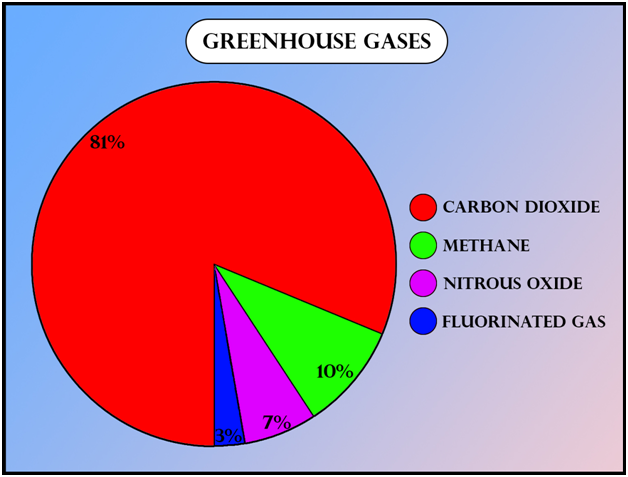
Which is not a greenhouse gas
A. Chlorofluorocarbon
B. Methane
C. Carbon dioxide
D. Hydrogen
Answer
583.5k+ views
Hint: Greenhouse gases are responsible for causing the greenhouse effect which is a naturally occurring that is responsible for heating the earth’s surface and atmosphere. Vehicular emissions, fossil fuels burning, as well as some basic processes like respiration, are some of the sources of greenhouse gases.
Complete answer:
Main gases responsible for the greenhouse effect are carbon dioxide(81%), methane(10%), Chlorofluorocarbon or CFCs(3%) and Nitrous oxide(7%). These gases are collectively known as greenhouse gases. They selectively allow the short-wavelength energy to pass through but absorb and reflect back the longer wavelength energy to the earth, thus, heating up the atmosphere. Without the greenhouse effect, the average temperature of the earth’s surface would have been an extremely cold planet rather than the present average of approximately 14°C.
The greenhouse effect is also associated with global warming where an increase in the level of greenhouse gases has led to considerable heating of the earth. Scientists believe that global warming is the reason behind many adverse and odd climatic conditions being witnessed in various parts of the earth. It has also induced the melting of polar ice caps as well as glaciers in Himalayan snowcaps. CFCs have depleted the ozone layer which is present in the stratosphere and protects us from harmful ultraviolet radiation.
To reduce global warming, reducing the usage of fossil fuels is encouraged along with many other steps such as reducing deforestation, improving the efficiency of energy usage, and slowing down the growth of the human population.

So, the correct answer is ‘Hydrogen’.
Note: Ultraviolet rays are highly injurious as they may have deleterious effects on ones’ DNA. It is high energy and can break bonds within these molecules and might induce mutation along with the ageing of skin and cancer. A high dose of UV-B radiation can lead to inflammation of the cornea and ultimately snow-blindness cataract, leading to permanent blindness.
Complete answer:
Main gases responsible for the greenhouse effect are carbon dioxide(81%), methane(10%), Chlorofluorocarbon or CFCs(3%) and Nitrous oxide(7%). These gases are collectively known as greenhouse gases. They selectively allow the short-wavelength energy to pass through but absorb and reflect back the longer wavelength energy to the earth, thus, heating up the atmosphere. Without the greenhouse effect, the average temperature of the earth’s surface would have been an extremely cold planet rather than the present average of approximately 14°C.
The greenhouse effect is also associated with global warming where an increase in the level of greenhouse gases has led to considerable heating of the earth. Scientists believe that global warming is the reason behind many adverse and odd climatic conditions being witnessed in various parts of the earth. It has also induced the melting of polar ice caps as well as glaciers in Himalayan snowcaps. CFCs have depleted the ozone layer which is present in the stratosphere and protects us from harmful ultraviolet radiation.
To reduce global warming, reducing the usage of fossil fuels is encouraged along with many other steps such as reducing deforestation, improving the efficiency of energy usage, and slowing down the growth of the human population.

So, the correct answer is ‘Hydrogen’.
Note: Ultraviolet rays are highly injurious as they may have deleterious effects on ones’ DNA. It is high energy and can break bonds within these molecules and might induce mutation along with the ageing of skin and cancer. A high dose of UV-B radiation can lead to inflammation of the cornea and ultimately snow-blindness cataract, leading to permanent blindness.
Recently Updated Pages
Two men on either side of the cliff 90m height observe class 10 maths CBSE

Cutting of the Chinese melon means A The business and class 10 social science CBSE

Show an aquatic food chain using the following organisms class 10 biology CBSE

How is gypsum formed class 10 chemistry CBSE

If the line 3x + 4y 24 0 intersects the xaxis at t-class-10-maths-CBSE

Sugar present in DNA is A Heptose B Hexone C Tetrose class 10 biology CBSE

Trending doubts
The average rainfall in India is A 105cm B 90cm C 120cm class 10 biology CBSE

Why is there a time difference of about 5 hours between class 10 social science CBSE

What is the median of the first 10 natural numbers class 10 maths CBSE

Indias first jute mill was established in 1854 in A class 10 social science CBSE

Indias first jute mill was established in 1854 in A class 10 social science CBSE

Write a letter to the principal requesting him to grant class 10 english CBSE




